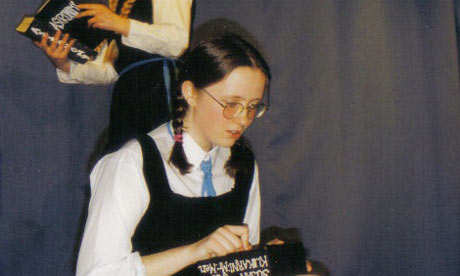
The day the optician told me I needed glasses, I burst into tears. I was 10 years old – gawky, bookish, rubbish at sport – and the chalk-marks on the school blackboard were looking increasingly blurry. Now, the optician said, I'd be able to see again – but only by attaching to my head what looked like an instrument of torture designed to extract the maximum potential for teasing. With their thick curved lenses and speckled green frames, my first glasses looked like something Timmy Mallett would wear. And that was definitely not a good thing.
Now, it seems, increasing numbers of children and teenagers are sharing my pain. Over the last couple of decades, there's been a massive surge in short-sightedness in young people around the world (the condition is usually diagnosed in teenagers). According to New Scientist, 80% of young adults now need glasses in Asian countries such as Singapore, Hong Kong and Taiwan – so many that you wonder whether the teasing tables have been turned (do the kids with 20-20 vision get called "two-eyed"?). Rates are lower over here – between 30 and 50% – but ophthalmologists agree that myopia is on the rise. "We can't be sure of the numbers," says Winfried Amoaku, consultant ophthalmologist at Queen's Medical Centre in Nottingham, "but the increase in myopia, especially in eastern countries, really is quite rampant."
So what lies behind this myopia epidemic? The traditional explanation has been reading, which some scientists think can cause the lenses in children's eyes to elongate, blurring the image recorded by the retina. Myopia does still seem to afflict bookish types more (just glance round your local library), but no one has found a definitive link. "Being short-sighted does not," Amoaku explains curtly, "mark you out as an intellectual."
Kids have been reading for centuries, anyway – and most prefer TVs and computers these days. So are screens to blame? Most ophthalmologists agree that excessive screen-watching can accelerate myopia – though Amoaku says it's fine as long as you stay at "piano-distance" from the screen (defined, quaintly, as the distance you'd sit from an upright piano).
The fall-off in school sport could also be a factor. Playing sport does seem to have a positive effect on children's eye health: one recent American study of eight-year-olds found that around one in five became myopic within four years – and almost all of those that did played little or no sport. But even more remarkably, our increasing tendency to keep kids indoors could actually be to blame. In a recent study of more than 2,000 12-year-old Australians, playing sport indoors turned out to be of no benefit for the eyes – but sitting around in the fresh air was.
Diet could also play a part. In 2002, the American evolutionary biologist Loren Cordain linked myopia with a high-carb diet, though that doesn't explain why the Asian diet – traditionally carbohydrate-rich – should only now be affecting sight. For Amoaku, then, the answer is to "do all the normal, healthy things, with a good diet and exercise". And even if that doesn't work, most short-sighted kids will eventually find – as I did – that wearing glasses is really nothing to cry about.

